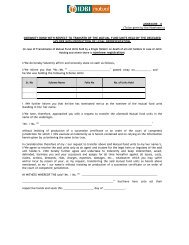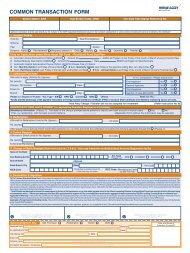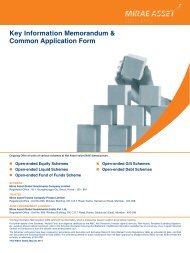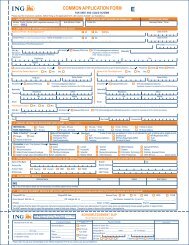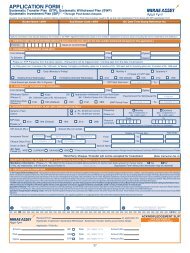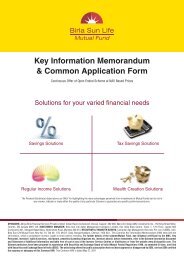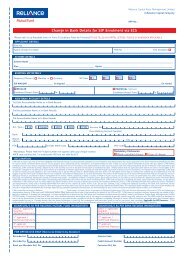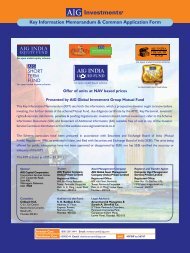COMMON APPLICATION FORM LIQUID, DYNAMIC BOND.pdf
COMMON APPLICATION FORM LIQUID, DYNAMIC BOND.pdf
COMMON APPLICATION FORM LIQUID, DYNAMIC BOND.pdf
Create successful ePaper yourself
Turn your PDF publications into a flip-book with our unique Google optimized e-Paper software.
Differentiation withexisting Open EndedDebt Schemes ofAxis Mutual Fund(as on March 31, 2011)(Contd...)Name of the existing scheme - Axis Income SaverAsset AllocationType of InstrumentNormal Allocation (% of net assets)Debt and money market instruments Minimum 65%; Maximum 99%Equity and Equity related instruments Minimum 1%; Maximum 35%Primary Investment Objective -The Scheme seeks to generate regular income through investments in debt & money marketinstruments, along with capital appreciation through limited exposure to equity and equity related instruments. It also aims to managerisk through active asset allocation.Differentiation - Investment in Equity and Equity related instruments up to 35% of the net assets of the scheme.AUM (`. In crores) 439.38 No. of Folios 25480Name of the existing scheme - Axis Dynamic Bond FundAsset AllocationType of InstrumentDebt instruments including GSecs and corporate debt 0% - 100%Money market instruments 0% - 100%includes securitized debt up to 30% of the net assets of the Scheme.Normal Allocation (% of net assets)Primary Investment Objective - The scheme will endeavor to generate optimal returns while maintaining liquidity through activemanagement of a portfolio of debt and money market instruments.Differentiation - Active duration management.Investment StrategyThe risk-return profile of this fund positions it in between a liquidfund and short duration income fund. The portfolio strategy seeksto increase yield by having a marginally higher maturity andmoderately higher credit risk as compared to a liquid fund; whilstmaintaining balance between safety and liquidity.The Fund Manager will try to allocate the assets of the scheme in adiversified portfolio of various high quality Fixed Income Securitiesto achieve stable returns while having a low risk strategy.The fund manager will seek to look for investment opportunitieswith the same class of fixed income securities (e.g. governmentsecurities) having different maturities (e.g. government securitieshaving a residual maturity of 1 year and 2.5 years) or differentclasses of Fixed Income Securities with the same maturityprofile/residual maturity. (e.g. a government security, an NBFCand a manufacturing corporate security having a residual maturityof 2 years).Risk Profile of theSchemeMutual Fund Units involve investment risks including the possible loss of principal. Please read the SID carefully for details on riskfactors before investment.Scheme specific Risk Factors are summarized below:The scheme carries risks associated with investing in debt and money market securities, derivatives, Foreign Securities, securitizeddebt, short selling and securities lending.Investment in mutual fund units involves investment risks such as trading volumes, settlement risk, liquidity risk and default risk.Trading volume may restrict liquidity. The AMC may choose to invest in unlisted securities which may increase the risk on the portfolio.Also, the value of the Scheme investments may be affected by currency exchange rates, changes in law/policies of the government,taxation laws and political, economic or other developments.Investments in debt and money market instruments are subject to interest rate risk, re-investment risk, basis risk, credit risk, spreadrisk, prepayment risk, etc. Please refer to the SID for further details.Risk ManagementStrategiesInterest rate risk is managed by meticulous determination ofaverage maturity (which is the expression for change in portfoliovalue for a basis point change in interest rate) of the portfolio.Extensive analysis of macro economic conditions is done to form aview on future interest rates and to position the portfolioaccordingly. Credit risk is managed by in-depth analysis of issuer(financial/operating performance) with the help of internal andexternal research. Liquidity risk is addressed by maintainingexposure to cash/cash equivalents and highly liquid instruments.Risk Management is an integral part of the investment process andadequate safeguards for controlling risks would be incorporatedby the Asset Management Company (AMC) in the portfolioconstruction process. The following are the key risks associatedwith investments in fixed income securities and the manner theAMC would endeavor to address themRisk InvolvedInterest Rate Risk: Risk that a rise in interest rates will cause priceof bonds to fall. In general, there is an inverse relationshipbetween interest rates and bond prices so that when interest ratesrise, bond price fall and vice versa.Risk Mitigant: The average modified duration of a portfolio is oneof the means of measuring the interest rate risk of the portfolio.Higher is the modified duration, the fund stands exposed to ahigher degree of interest rate risk. The Investment ReviewCommittee (IRC) of the Asset Management Company woulddecide on the modified duration to be maintained for the portfolioat a particular point of time after taking into account the currentscenario and the investment objective of the scheme. Theportfolio duration will be decided after doing a thorough researchon the general macroeconomic condition, political environment,systemic liquidity, inflationary expectations, corporateperformance and other economic considerations.Credit Risk: Risk of default on payments by the issuer of a securityRisk Mitigant: The credit analyst will make a detailed study of eachof the issuers whose security will be bought by the fund. Hisanalysis will include a study of the operating environment, pasttrack record and short term/long term financial health of theissuer. The credit analyst will also take the help of data fromexternal credit rating agencies like ICRA, CRISIL and Fitch duringhis analysis. The Credit Analyst will recommend the name of theissuers to the IRC who will be the final approving authority forincluding any issuer in the “target universe of issuers”.Liquidity RiskRisk Mitigant: The Mutual Fund will maintain adequate cash/cashequivalent securities to manage the day to day redemptions of the2



